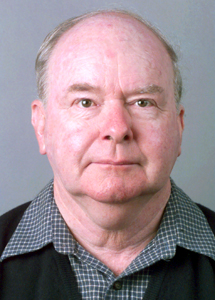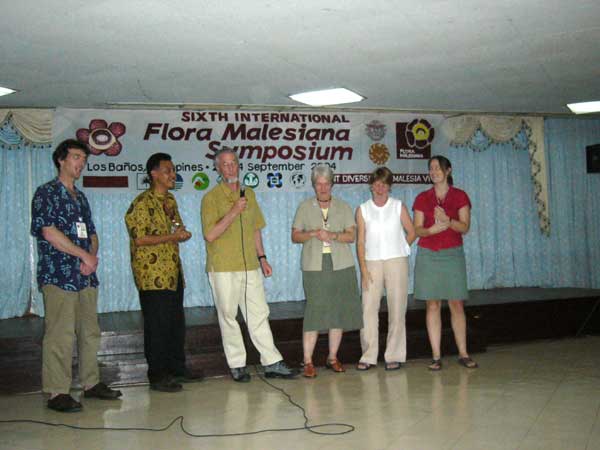 |
Centre for Australian National Biodiversity
Research
|
CPBR NEWS
Issue 63: September 2004
News from the Centre for Plant Biodiversity Research, Australian National Herbarium (CANB), for the information of CPBR and ANBG staff and volunteers.
CPBR News is produced monthly. If you wish to contribute, please email your suggestions to Val Oliver, the coordinator.
Val Oliver: ph (02) 6246 5533; fax (02) 6246 5249; email: Val.Oliver@csiro.au
********************
1. Staffing News
Richard Groves CSIRO 1966-2004
 This
Monday we will bid a formal farewell to Richard Groves, though the good news
is that he is staying on post-retirement as a CSIRO Honorary Research Fellow.
Richard is known to most of us in the Centre as our "weed ecologist"
and it is in this area that he has probably had most impact on botany in Australia
and internationally. Richard began his career at the University of Melbourne
where he completed his bachelors degree in 1960 and a PhD (entitled "Experimental
Studies on Heath Vegetation") in 1964. From there he moved on to a post
doc at the California Institute of Technology on "Developmental Physiology
of Scrophularia marilandica". He then had a brief stint at Michigan
State University. Richard joined the CSIRO in 1966 to work on the ecology
of skeleton weed managing to squeeze in a trip to France, Spain and Italy
on the way home to visit various institutions to conduct preliminary research.
This
Monday we will bid a formal farewell to Richard Groves, though the good news
is that he is staying on post-retirement as a CSIRO Honorary Research Fellow.
Richard is known to most of us in the Centre as our "weed ecologist"
and it is in this area that he has probably had most impact on botany in Australia
and internationally. Richard began his career at the University of Melbourne
where he completed his bachelors degree in 1960 and a PhD (entitled "Experimental
Studies on Heath Vegetation") in 1964. From there he moved on to a post
doc at the California Institute of Technology on "Developmental Physiology
of Scrophularia marilandica". He then had a brief stint at Michigan
State University. Richard joined the CSIRO in 1966 to work on the ecology
of skeleton weed managing to squeeze in a trip to France, Spain and Italy
on the way home to visit various institutions to conduct preliminary research.
At the CSIRO Richard worked on the skeleton weed project. He also developed an interest in the ecology and physiology of kangaroo grass, particularly in factors controlling the shift in grassland composition from themeda dominated to poa dominated in the context of the agricultural utility of native pastures. In 1969 he also became chair of Plant Industry’s Ecology Section. Through this time Richard’s international reputation as plant ecologist grew and from 1974-75 Richard was a Visiting Scientist at the Department of Pasture Science at the University of Natal. Then, in 1981, he was awarded a Senior Research Fellowship by the DSIR and spent time at their Grassland Division in New Zealand. It was also during this period that Richard made an unexpectedly (in retrospect) important decision, hiring a young post doc by the name of Jeremy Burdon!!
In 1992 Richard went to Montepellier as Officer in charge of the CSIRO Biological Control Unit where he stayed until 1995, during which time he worked on thistles. On returning to Canberra Richard initiated much of his recent work on sleeper weeds, which he continued as a Visiting Professor at the Centre for Research on Wild Plants at Utsunomiya University in Japan, where he worked on Oxalis for 6 months between 2002 and 2003. This year marks 38 years of Richard’s scientific contributions to the CSIRO Division of Plant Industry and, over the last 10 years, the CPBR. As you can see from this brief outline, these contributions have been significant and diverse (139 publications) and I would like you all to join me in wishing him a happy retirement and a productive time as an HRF.
[Andrew Young]
********************
2. Australian National Herbarium
Atherton Herbarium – as part of a collaborative organisation?
Senior managers of four existing scientific institutions, including the Centre for Plant Biodiversity Research, are currently exploring the possibility of developing a collaborative partnership in north Queensland based around the Atherton Herbarium collection. As part of the Public Service Management Program (PSMP) (Graduate Certificate, Macquarie University) it was decided my final work-based project would be to examine the benefits, risks and other dynamics inherent with collaborative organisations. This project would help CPBR management and collaboration partners make informed choices relating to the risks and benefits likely to be encountered with a collaborative scientific partnership.
Managers from three existing scientific collaborations (CPBR, Reef CRC and the Australian Centre for Plant Functional Genomics) were surveyed to provide insights into the experienced strengths and weaknesses of working within a collaborative governance arrangement. Comparison of these survey results was made to those of a second survey, which focused on the perceived opportunities and threats associated with the north Queensland collaboration.
Survey results showed the benefits of forming a collaborative partnership included the ability to tackle larger, broader goals than otherwise would be possible; sharing of information and staff expertise; cost savings through shared capital costs and adding value to the north Queensland economy. Significant risks included perceptions of partnership inequality, conflict with pre-existing organisational cultures and stakeholder conflict over strategic objectives. Mitigation strategies to help manage these risks were provided along with recommendations on stakeholder dynamics. More details are available in the project report, which will be available in the CPBR library shortly.
Overall the PSMP helped give me a good overview of contemporary management techniques and the issues facing current public service managers. I would like to thank Judy, Jim, Val and the Centre staff who helped me to get through the last 18 months and countless assignments!
[Anthony Whalen]
********************
3. Research Groups
Flora Malesiana Symposium
A Short Note from The 6th International Flora Malesiana Symposium,
University of Philippines, Los Banos, 20 – 24 September 2004
Flora Malesiana is a long-term international project that aims to document, describe, and classify the plants of Malesia in a series of family treatments summarizing existing and new information about the plants of the region. The project is undertaken by a world-wide network of plant scientists working in botanical institutions and universities in various countries coordinated from the University of Leiden in the Netherlands, under the direction of the Board of the International Flora Malesiana Foundation.
From 20 to 25 of September 2004, Lyn Craven, Ed Biffin, Judy West, Gill Brown (University of Melbourne), Janelle Stevenson (RSPAS, ANU), and I attended the 6th International Flora Malesiana Symposium at University of Philippines Los Banos (UPLB), Philippines. Simultaneously, Judy was attended the International Association for Plant Taxonomy (IAPT) Council meeting held in the Centre for Forest and Natural Resources Research (CFNR) .
Comprising 17 countries and 140 participants, the venue became the most important event for botanists for sharing the knowledge and the progress of their research of the Malesian plants and its surrounding regions including Australia. Our presence as the Australian delegation was reflected in "Waltzing Matilda" sung (under duress) by 6 of us in front of the Vice Chancellor UPLB Winfredo P. David and all participants during the welcome dinner at the Student Union Hall, at University of Philippines, Los Banos Campus.
Tuesday, September 21, 2004, was a "Phylogeny" day and was the busiest day for most of us. Lyn Craven presented his paper in the first session of the day followed by Ed and Gill in the second session. I was the last speaker in the last session for the day and I found this time is the most unfortunate time for a speaker especially after all participants have been bored with phylograms all day long. Fortunately, we all managed to give a clear and comprehensive presentation and showed to the audience that we in CPBR have also conducted deep study on Malesian plant families as well as its biogeography and its linked to the Australian flora.
Wednesday was a "Fieldtrip" day. Lyn and Gill climbed up Mt Makiling, Ed and I collected plants at Mt Makiling forest reserve while Judy worked at CFNR office. This relaxation day then followed by two days heavily loaded with numerous presentations on floristic studies, bioinformatics, cryptogams, ethnobotany, workshops, and posters session. The final remark from DR. Domingo Madulid on Friday, late in the afternoon officially closed the whole symposium program and ended the marvelous hard work of DR. Edwino S. Fernando (Co-chair of the symposium) and his team. We left Los Banos and the Philippines on Saturday with a big hope that all of us could meet again in the 7th International Flora Malesiana Symposium at Leiden, Netherlands in 2007. "Salamat Po"
[Teguh Triono, Ed Biffin, Lyn Craven, & Judy West]
|
|
********************
CPBR Board Meeting
The next meeting of the Board is Monday 11 October 2004.
[Val Oliver]
*******************
CPBR Executive Committee
The next meeting of the Executive Committee is 13 October 2004.
[Val Oliver]
*******************
